MUSCULOSKELETAL RESEARCH CENTER - 2003
Savio L-Y. Woo, Ph.D., D.Sc.(Hon.) - Center Director and Vice Chairman for Research
Table of Contents
[ Introduction ]
The Musculoskeletal Research Center (MSRC), established here in Pittsburgh twelve years ago, continues to be a flourishing enterprise. The four sections of the MSRC each specialize in different areas of orthopaedic research. The Mechanobiology and Biomedical Engineering Laboratories, located in the 16th floor of Biomedical Science Tower, overlook the University of Pittsburgh campus. The Ferguson Laboratory, directed by Drs. James Kang, Raj Sinha and Constance Chu, has a long history of orthopaedic research, dating back to the 1950’s and is located in Presbyterian University Hospital. The Growth and Development Laboratory, directed by Dr. Johnny Huard and located in the Rangos Research Center, focuses on characterization of the relationship of the biomechanical, morphological, and molecular aspects of the musculoskeletal system that pertain to tissue growth and maturation. The Neuromuscular Research Laboratory, directed by Dr. Scott Lephart and located in the newly built Center for Sports Medicine, integrates clinical based research and development into orthopaedic and sports medicine practice in order to improve the quality of injury prevention, management and rehabilitation. The diversified interests of these four sections, as well as collaborations between them, enable us to form a strong team to pursue multidisciplinary orthopaedic research.
This was a tremendous year for bringing in new funding. We have earned four new R01 grants from the National Institutes of Health (NIH): 1) Dr. James H-C. Wang earned his first R01 grant from NIH worth approximately $1,000,000 to study tendon inflammation and degradation, 2) Dr. Woo, together with Dr. Richard Debski and Dr. Fu, were successful in a competitive renewal for $1.2 million to study in situ forces in the ACL and ACL reconstruction. This is the fourth time that NIH has renewed this project, 3) Dr. Christopher Niyibizi earned $1.3 million from the NIH to study stem cell therapies, and 4) Dr. Johnny Huard had earned his third NIH grant worth more than $1.2 million to study stem cell transplantations. What wonderful accomplishments to enable us to continue quality research for several years to come!
Currently, our department has 14 funded NIH Grants worth over $15 million. We have also submitted an additional 5 NIH proposals that are in the review process (summarized in the table below).
| Currently Funded NIH Grants | ||||
| 1. NIH R01 | Drs. Woo/ Debski / Fu * | In-situ forces in ACLs | 4 years | 1,288,709.00 |
| 2. NIH R01 | Drs. Woo/ Wang/ Niyibizi | MCL Healing | 5 years | 1,853,621.00 |
| 3. NIH R01 | Dr. Niyibizi * | Stem Cell Therapy | 4 years | 1,302,980.00 |
| 4. NIH R21 | Dr. Chu | Superoxide Dismutase | 3 years | 321,986.00 |
| 5. NIH R01 | Dr. Vogt | Lumbar Spinal Stenosis | 4 years | 311,216.00 |
| 6. NIH R01 | Dr. Huard | Muscle Healing | 5 years | 1,071,720.00 |
| 7. NIH R01 | Dr. Huard | Bone Healing | 5 years | 1,624,012.00 |
| 8. NIH R01 | Dr. Huard * | Stem Cell Transplantation | 5 years | 1,225,000.00 |
| 9. NIH R01 | Drs. Gilbertson / Kang | Robotic Spine Testing | 3 years | 721,348.00 |
| 10. NIH R01 | Drs. Chancellor / Huard | Gene Therapy for Incontinence | 5 years | 381,000.00 |
|
11. NIH R01 Supplement |
Dr. Wang * |
Mechanisms for Tendinitis Support for Crawford |
4 years |
957,202.00 183,519.00 |
| 12. NIH P01 | Drs. Huang / Huard | Myofibers | 5 years | 1,063,304.00 |
| 13. NIH P30 | Drs. Wright / Wang | Tendinitis | 3 years | 225,000.00 |
| 14. NIH R01 | Dr. Lovell | MRI & Sp Related Concussion | 5 years | 2,856,387.00 |
| Total Funded NIH Grants | $15,387,004.00 | |||
| Pending NIH Grants | ||||
| 1. NIH R01 | Dr. Wang | Functional Tissue Eng - MCL | 5 years | 1,390,000.00 |
| 2. NIH R01 | Drs. McMahon / Debski | Restoring Joint Stability | 5 years | 1,143,613.00 |
| 3. NIH R01 | Drs. Moalli/Woo/Niyibizi | Impact of Menopause | 5 years | 1,645,080.00 |
| 4. NIH R01 | Dr. Kang | Matrix Synthesis | 5 years | 1,745,937.00 |
| 5. NIH Core | Drs. Wagner / Huard | Precursor Cell Isolation | 5 years | 528,284.00 |
| Total Pending NIH Grants |
|
|||
We are, indeed, very satisfied with the efforts and accomplishments of each and every individual laboratory. Using the level of NIH funding as a measure for success, we are doing exceedingly well for a young research center. More importantly, we are excited about innovative projects that being conducted at our center as well as our significant productivity. Each of our laboratories have built dynamic teams and their research are moving forward in developing new strategies to treat orthopaedic injuries and disease. We thank everyone for their hard work. It is truly a pleasure for us to serve in the leadership position.
Another strength of the MSRC is the continual collaboration between the principal investigators. The multidisciplinary approach has improved our understanding and provided read advancements. Examples include Drs. Woo and Lephart on assessing and reproducing the in vivo knee kinematics during activities of daily living. Drs. Woo, Niyibizi, and Wang are collaborating on changing the collagen composition of the healing MCL using antisense gene therapy. Drs. Huard and Woo working on the determination of the effect of BMP2 and BMP4 on the mechanical properties of bone. Dr. Wang and Dr. Fu are working on a study to evaluate the effectiveness of treating tendinopathy with radiofrequency currents.
The following describe the activities of the Mechanobiology and Biomedical Engineering Laboratories. The Ferguson, Growth and Development, and Neuromuscular Research Laboratories will be discussed in more detail in subsequent sections.

Drs. Wang, Li, Woo, Debski and McMahon
The Mechanobiology and Biomedical Engineering Laboratories have three primary research foci: 1) functional tissue engineering, 2) robotics and computational biomechanics, and 3) neuromuscular control. There are seven laboratories, Mechanobiology, Tissue Mechanics, Anterior Cruciate Ligament, Posterior Cruciate Ligament, Computer Assisted Surgery, Shoulder Dynamics, and Hand and Forearm Laboratories. Functional tissue engineering research investigates the cellular and molecular responses to mechanical stimuli and manipulates these processes to improve the outcome of healing. The robotics and computational biomechanics research uses robotic technology and computational techniques to examine joint function and detail the contribution of individual ligaments and other soft tissue structures. Specifically targeted in quantifying the in situ forces of knee and shoulder ligaments to improve ligament reconstructions with the hope of improving joint function following surgical repair. The goal of our neuromuscular control research is to advance our understanding of finger coordination mechanisms, how hand disorders affect finger coordination, and how clinical treatments can improve finger coordination. We are particularly interested in studying carpal tunnel syndrome using bioengineering principles. Our research will potentially improve prevention, diagnosis, evaluation, and treatment of carpal tunnel syndrome.

MSRC in the Summer of 2002

|

|
|
| Dr. Woo and the AOSSM traveling fellows | Drs. Woo and Debski with the ASG traveling fellows |
[ top ]
[ Accomplishments ]
This past year was both exciting and successful for the MSRC, as we submitted and received 6 new grants, hosted an international symposium, submitted and published new manuscripts, edited books, presented at national and international meetings, delivered distinguished lectures as the recipients of national awards, and were also highlighted in a UPMC television commercial.
The faculty is very active in the Bioengineering Department and also in societies outside of the University. Dr. Debski is currently teaching a course on “Mechanical Principles Applied to Biological Tissues” in addition to teaching the Ligament Lab for BIOE 1150 and lecturing in the course “Biodynamics of Human Movement”. Dr. Wang is currently teaching “Cell Mechanobiology” for bioengineering and mechanical engineering graduate students in addition to the Internship Program and coordinating the Bioengineering Department’s Research Experience for Undergraduates (REU) Summer Program. Dr. Li is the laboratories Coordinator of the Graduate Student Admissions Committee as well as a member of the Bioengineering Department’s Graduate Student Admissions Committee. Additionally, Dr. Debski is organizing the Soft Tissue Mechanics Session at the upcoming meeting of the American Society of Mechanical Engineers (ASME). Dr. Debski also earned election into the American Shoulder and Elbow Society (ASES) as an Affiliate Member this year. There are less than a dozen Affiliate Members in ASES.

|
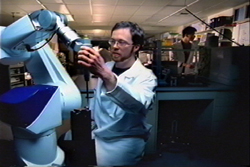
|
| The MSRC stars in UPMC commercial | |
In November, the Mechanobiology and Biomedical Engineering Laboratory responded to a casting call for the new UPMC commercial. Dr. Debski and staff engineer, Andrew Van Scyoc, can be seen in the new ad. Also featured is one of two robotic/UFS testing systems in our laboratory. After 10 years of effort and numerous publications, our novel robotic/UFS testing system has been well accepted by the research and clinical community. Mr. Van Scyoc is seen operating the CASPAR robot, which drills tunnels in the femur and tibia for ACL reconstruction.
The MSRC sponsored a third symposium this year at the Orthopaedic Research Society (ORS) Meeting. Drs. Zong-Ming Li, Fengyan Jia, and Savio Woo organized The Third International Symposium on Ligaments and Tendons in New Orleans, La with cooperation of local hosts, Dr. Derek Jones and Ms. Gerry Savage of the Tulane University Medical School. The goal of this symposium is to bring together researchers with diverse backgrounds to present and discuss new developments in the study of ligaments and tendons. There were four sessions devoted to biology and function, biomechanics, tissue engineering and pathophysiology in addition to a special symposium on tendinopathy. With 110 attendees, this meeting was unique in that there was extra time allotted for discussion to allow students and faculty to receive extensive quality feedback on their research. This meeting generated a lot of new research questions and much interest from others in the field, it is sure to be an annual meeting for years to come.
[ top ]
[ Honors and Awards ]
In addition to all of the NIH funding that we have earned, we have also been successful in gaining extramural funding from other sources. Dr. Li received a grant from the Whitaker Foundation for $225,000 to study human finger coordination and another grant from the Aircast Foundation for $100,000 to study hand motor function. The Whitaker Foundation has awarded a three-year grant for $165,600 to Drs. Wang and Woo in the Department of Bioengineering for the establishment of an Industrial Internship program. The Industrial Internship Program is designed to assist bioengineering students in achieving educational and career goals. This program will provide a mechanism for an individualized, industrial-based educational internship experience. Dr. Wang received $40,000 from the Alternative Research and Development Fund (ARDF) to investigate mechanisms of tendinitis. Dr. Li also received a grant from Hewlitt International to travel abroad and promote international collaborations. Additionally, NIH awarded a supplemental grant to support Dr. Wang’s new graduate student, Mr. Richard Crawford.

Sir Arbuthnott, Professor Woo, Sir Robertson
In terms of notable awards, Dr. Woo received the Carnegie Centenary Professorship sponsored by the University Court of the Universities of Scotland. The Carnegie Centenary Professorship is one of the highest honors from the highest academic institutes in Scotland. Dr. and Mrs. Woo traveled to Scotland in September to work with Professor Malcolm Pope at the University of Aberdeen as well as six other Universities in Scotland. In addition, Dr. Woo had the opportunity to present his work to a wider audience. As a result of his visit, we have a great opportunity for our department as well as the MSRC to explore the use of vertical MRI to study the in vivo kinematics of the knee and shoulder joints and establish collaborations with Dr. Malcolm Pope of the University of Aberdeen.
The Shoulder Dynamics Team won the prestigious 2003 Achilles Orthopaedic Sports Medicine Research Award from the International Society of Arthroscopy, Knee Surgery and Orthopaedic Sports Medicine (ISAKOS) for their work entitled “Biomechanical Evaluation of Three Common Reconstruction Procedures for Complete Dislocations of the Acromioclavicular Joint” by Dr. Raj Jari, Mr. Ryan Costic, Dr. Mark Rodosky and Dr. Richard Debski. The Posterior Cruciate Ligament Group won the 2003 Cabaud Award from the American Orthopaedic Society for Sports Medicine (AOSSM) for their work entitled “Effects of Combined PCL and Posterolateral Corner Reconstruction on Knee Biomechanics” by Dr. Jon Sekiya and co-workers under the direction Dr. Christopher Harner. The Anterior Cruciate Ligament Laboratory won the 2002 Richard O’Connor Award from the Arthroscopy Association of North America (AANA) for their work entitled “Knee Stability and Graft Function Following Anterior Cruciate Ligament Reconstruction: Comparison Between 11 O'clock and 10 O'clock Femoral Tunnel Placement” by Drs. John Loh, Yukihisa Fukuda, Eiichi Tsuda, Richard Steadman, Freddie Fu and Savio Woo. Dr. Loh presented this work at AANA’s annual meeting last year.

Reciepients of 2003 Achilles Awards: Mark Rodosky, Raj Jari, Ryan Costic, Richard Debski
Our high productivity is evidenced also by the papers we have published in refereed journals and abstracts we presented at meetings. Last year, we submitted 28 new manuscripts, including a record number of 6 manuscripts in the month of June alone. Among the papers that we published last year was “Cell orientation determines the alignment of cell-produced collagenous matrix” by Dr. James Wang, Dr. Fengyan Jia, Mr. Thomas Gilbert and Dr. Savio Woo that was published in the Journal of Biomechanics. “Glenohumeral Translations are Only Partially Restored after Repair of a Simulated Type II Superior Labral Lesion” written by Drs. Andreas Burkhart, Richard Debski, Volker Musahl, and Patrick McMahon published in the American Journal of Sports Medicine. “The influence of wrist position on individual finger forces during forceful grip” by Dr. Li was published in the American Journal of Hand Surgery. In the American Journal of Bone and Joint Surgery, “The effectiveness of reconstruction of the anterior cruciate ligament with hamstrings and patellar tendon: A cadaveric study comparing anterior tibial and rotational loads” was published, authored by Dr. Woo, Dr. Kanamori, Ms. Zeminski, Dr. Yagi, Dr. Papageorgiou, and Dr. Fu.
Dr. Woo also co-edited two books this year. First, Dr. Woo is a co-editor with Dr. Michael Kjaer of the recently published Textbook of Sports Medicine. Second, Dr. Woo is working with Dr. Ned Hwang on the “New frontiers in Biomedical Engineering”.
We were honored with appointments from Universities outside of the US last year. The University Court of Scotland offered Dr. Woo an honorary appointment as Visiting Research Professor in the Bio-Mechanics and Bio-Materials Group. Dr. Li was named a Guest Professor at Sichuon University in Chengdu, China and Dr. Woo received an Honorary Professorship from the same institution. Dr. Wang was also named a guest professor at Tongji University in Shanghai, China and Dr. Woo received an Honorary Professorship from Tongji University as well. Dr. Woo was awarded an Honorary Professorships from Fudan/ Hua Shan Hospital Universities in Shanghai, China. Strong ties with these universities are being established.
[ top ]
[ Personnel ]
The past year was a wonderful year, as we have added new and key members to our team! Dr. Fengyan Jia, formerly a research fellow coming to us from China, has become a staff researcher. She now directs the project on using antisense oligonucleotides to improve MCL healing. Dr. Jia has proved to be a tremendous asset to the MSRC. Ms Maribeth Thomas has decided that the MSRC is where she would like to work and is now a staff research engineer actively working on ACL projects. Miss Thomas has a bachelor’s degree in Bioengineering from the University of Pittsburgh. She is currently working on collecting and reproducing knee motion on the robotic/UFS testing system. Mr. John Jolly also joined the Shoulder Dynamics Team full time after completing his bachelor’s degree in Bioengineering here at the University of Pittsburgh in December 2002. Mr. Jolly is working on revitalizing the Dynamic Shoulder Testing Apparatus and updating the hardware and software associated with the device.

|
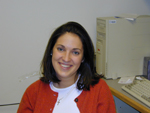
|
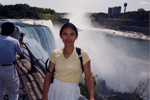
|
| Mr. John Jolly | Ms. Maribeth Thomas | Dr. Fengyan Jia |
The MSRC welcomed several foreign post-doctoral research fellows this year. Dr. Yoshiyuki Takakura joins the ACL and MCL Groups. He comes from a long line of fellows sent to us by Professor Masahiro Kurosaka of Kobe University School of Medicine in Kobe, Japan and we are excited for him to lead us in an in-vivo study of MCL healing using SIS scaffold. Dr. Yuji Yamamoto joined us this year, sent to us by Professor Satoshi Toh from Hirosaki University in Japan, and is working with the ACL group. Dr. Yamamoto will compare the effectiveness of two ACL reconstruction techniques. The Hand and Upper Extremity group recruited Mr. Shouchen Dun from Case Western Reserve University (in the great city of Cleveland) to work on projects relating to hand motor function and carpal tunnel syndrome. Hailing from Turkey, specifically Kayseri Military Hospital, Dr. Feridun Cilli is working with the Tendinitis group during his year in Pittsburgh. Dr. Cilli has been teaching us about the great history of Turkey and amazing ruins found in Turkey. Dr. Guangqing Wang also joined the Tendinitis group; he comes to us from Changhai Hospital in Shanghai, China. The ACL group also recruited a new post-doctoral fellow, Dr. Xinguo Ning, who just graduated from the Mechanical Engineering Department at the University of Pittsburgh. He will be continuing the finite element modeling of the ACL and knee that Yuhua Song, Ph.D. had begun. Dr. Wei-Hsiu Hsu was sent to us by Professor Robert Hsu of Chang Gung Memorial Hospital in Chia Yi, Taiwan. Coming from a region where the temperature does not drop below 50 degrees, Dr. Hsu is really enjoying the snow and cold weather we have in Pittsburgh. Additionally, Dr. Robert Kilger from Heidleburg Germany has recently arrived in Pittsburgh. Dr. Kilger is eager to begin working with the ACL group and the robotic/UFS testing system. Additionally, we welcomed Dr. Chris Ugbolue, who also has assumed a role as a research fellow after completing his doctoral requirements in bioengineering at the University of Strathclyde in Scottland. Dr. Ugbolue will undertake projects related to repetitive strain injuries.
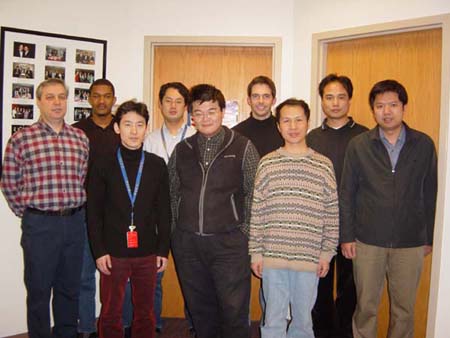
Feridun Cilli, Chris Ugbolue, Yuji Yamamoto, Yoshiyuki Takakura, Wei-Hsui Hsu, Robert Kilger, Xinguo Ning, Shouchen Dun, Guoangqing Yang
We also welcomed two first-year residents in July 2002 to spend a year doing orthopaedic related research in the MSRC. Dr. Joanne Labriola and Dr. Mustafa Khan are performing biomechanics and mechanobiology related musculoskeletal research. Dr. Labriola is working on projects in the Shoulder Group under the direction of Drs. Debski and McMahon. Dr. Labriola received her medical degree from the University of Pittsburgh. Dr. Labriola’s current research project is focused on the shoulder ligament reconstruction and replacement techniques. We are enjoying all of the Italian treats that she brings to us in the lab. Dr. Khan graduated from the University of Pennsylvania and is working in the Tendinitis Group under the direction of Dr. Wang.
The MSRC welcomed nine new graduate students this year. It has been a fabulous year for recruitment, thanks to the efforts of Dr. Zong-Ming Li. The Hand and Upper Extremity group welcomed Danny Harkness, BS, who received a degree in electrical engineering from Sacramento State University, where he played varsity baseball. Joining the ACL group this year, from the University of Rochester is Scott Hanford, B.S., who enjoys soccer and is using the robotic/UFS testing system to determine changes in knee motion due to partial tears of the ACL. Three new graduate students joined the Mechanobiology Laboratory this year: Wei “Willis” Shen, M.S., M.D. from Shanghai Second Medical University (star basketball player), Charu Agarwal, B.A. from the University of Rochester (religious watcher of “The Bachelorette”), and Richard Crawford, B.S. from the University of Pittsburgh (a.k.a. Rico-suave). Three new graduate students also have an interest in studying MCL healing and functional tissue engineering: Li “David” Zou, M.S., M.D. from West China University of Medical Sciences (an engineer with surgical skills, he is sure to be a tremendous asset), Daniel Moon, B.S. from Virginia Commonwealth University (an enigma?), and Sarah Brown, B.A. from Kent State University (always busy running collagen gels, yet still finds time to help everyone).
Of course, we also had to say goodbye to some dear friends. Brian Campbell, M.S. graduated with a Master’s degree and is now in medical school at the University of Pittsburgh. His advisor, Dr. Wang, and the entire MSRC is very proud of him. After nearly two years in the MSRC, Dr. Yuhua Song was offered a position at Washington University in St. Louis. She is now doing mathematical modeling at a cellular level. After two years as a research fellow, Dr. Volker Musahl has also graduated from MSRC. He buckled down this past year and studied for the USMLE exams and passed them all. Congratulations! He is planning to do a residency program in Orthopaedic Surgery. Dr. Takatoshi Shimomura also completed his research fellowship and returned to Japan. We miss his leadership in the antisense gene therapy project. We wish them all the best in their new endeavors.
[ top ]
[ Summer Student Program ]
In the Summer Undergraduate Research Program, students have the opportunity to work directly with a team from one of the research groups throughout the summer. This program has a ten-year history and every year seems to get better. This year, Dr. Debski coordinated the program and led by three key words: education, productivity and fun. The program culminated on July 18, 2002 with a symposium where each student presented his or her accomplishments. This year we ten undergraduate students from the University of Pittsburgh, Carnegie Mellon University, The University of Akron and Rochester Institute of Technology participated in the program. The projects were diverse, varying from functional tissue engineering and gene therapy to robotics technology. At the end of the summer, each student was dubbed with a special award. This years students and awards included: Erdrin Azemi, “New Idea Award”; Tom Christophel, “Clinical Study Award”; Jonita Cutts, “Engineering Award”; Rebecca Hrutkay, “Promising Hypothesis Award”; Daphne Kontos, “validation and Accuracy Award”; Katherin Peperzak, “Super Kitty Award”; and Mara Schenker, “Animation and Presentation Award”; Christina Casella, “Numerical Modeling Award”; Morgana Martin, “Frontier of Science and Engineering Award”; and Kristin Moffat, “Design Award”; Casey Castner, “Clinical Relevance Award”; and Nicole Paga, “Appreciation of Literature Award”. Additionally, Summer Student of the Year Awards were given to Mara Schenker and Erdrin Azemi for their work during the summer, not only for research excellence, but also for helping others, volunteering in the lab, and leadership amongst the summer students. This is an exciting program and we are looking forward to next year.
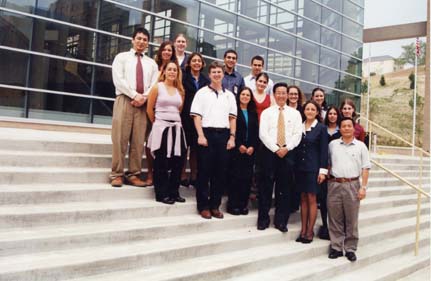
2002 Summer Students with Faculty Advisors
[ top ]
[ Special and Social Events ]
Andy Van Scyoc proposed to his long time sweetheart, Lucy Miller, in December when they were on vacation in Seattle. She said yes! They have not determined a wedding date as of yet, we wish them many wonderful years together. Dr. Yuji Yamamoto and his wife, Noriko, had their first son, Reo (they wanted to name him Leo, bun unfortunately, the Japanese language does not have an “l”) on September 28, 2002. Serena and Kyi Saw had their second son, Caleb Matthew, born June 18, 2002. While some MSRC families were blessed with new additions, others were graduating children and sending them off to school. Miss Qing Yang, daughter of Mr. Guoguang Yang and Mrs. Jianyin Zhang, started school at Yale University this fall. Mrs. Jane Peart and her husband, Dewitt, sent their oldest son, Michael, to the University of Chicago and their youngest son, Andrew, to Central Catholic this fall. Congratulations to their families.
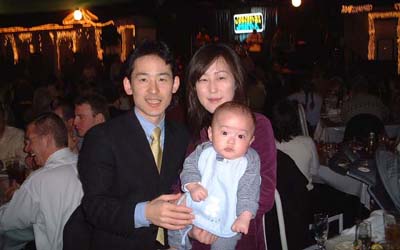
Yuji, Noriko and Reo Yamamoto
The MSRC held its annual potluck heritage dinner this summer at the home of Mrs. Diann and Mr. Lou Decenzo. There was lots of great food from around the world, including Japanese, Chinese, Italian, German, Egyptian, Albanian, and good old American cuisine. It was a beautiful day that allowed the kids to enjoy the swings and sandbox and allowed the bigger kids to play horseshoes. To celebrate the MSRC’s productivity, we had a dinner at the Orient Kitchen last summer in recognition of the submitting a record number of papers to refereed journals and the successful completion of the summer students’ projects. The MSRC also enjoyed watching the U.S. vs Germany World Cup Soccer Match (U.S. should have won!) at Dr. Woo’s home. Mrs. Woo served up a fabulous breakfast accompanied by Krispy Kreme donuts. Last summer the MSRC also enjoyed a white-water rafting trip on the Youghiogheny River. Fortunately, there were no injuries, however, many of us did get very wet.
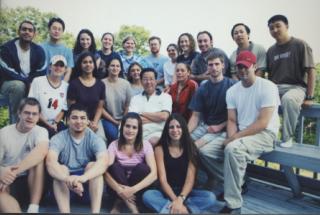
During ORS and ISL&T III meetings in February, the MSRC, once again, made a great showing presenting presentations and posters with clarity and panache. The MSRC luncheon was held at Mike Anderson’s on Bourbon Street in New Orleans, LA. We enjoyed a delicious lunch with present and past members of the MSRC.
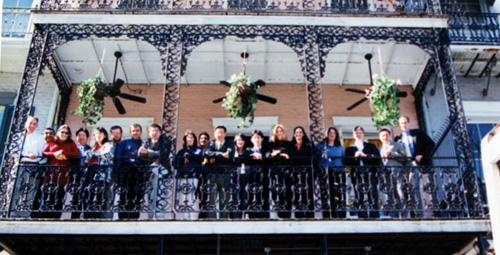
The MSRC at Mike Anderson's (former Pittsburgh Steeler) in New Orleans
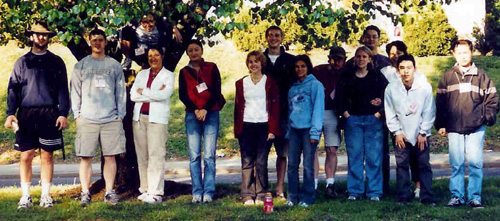
MSRC medical volunteers at Pittsburgh Marathon 2003
[ top ]
